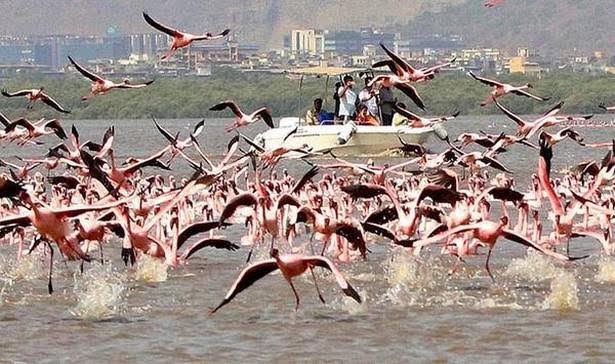Thane Creek Flamingo Sanctuary accounts for Rs. 46 lakh carbon sequestration per annum: Maha govt.
Every year the 896-hectare (ha) mangrove cover at Thane Creek Flamingo Sanctuary (TCFS) stores 2,688 tonnes of carbon which comes mostly from the pollutants released into the atmosphere. The estimated carbon sequestration volume was valued at ₹46 lakh per year as an ecosystem resource, apart from being a safe haven for migratory birds and other species.
Mangroves are salt-tolerant plants and so protect the coastline from inundation, capture and store carbon dioxide (CO2) from the atmosphere. The process is called carbon sequestration, and it helps control rising global temperatures by reducing CO2 levels in the atmosphere. The carbon sequestration study for TCFS was carried out by the Wildlife Institute of India (WII), Dehradun, while preparing the management plan. The mangrove cell also studied two locations – Bhandup and Airoli – through another study where the quantum of carbon sequestered was calculated at 37.3 tonnes per ha from Avicennia marina species (most dominant in the creek).
In August 2016, the state declared the northern part of Thane creek – that includes a flamingo sanctuary spread over 1,690 ha (896 ha mangroves and 794 ha land adjacent to a water body) – as tourism zone to safeguard the flamingo population. The area is home to 12 true mangrove species and 39 mangrove associates, 167 species of birds, 45 fish species, 59 species of butterflies, 67 insect species.
Meanwhile, a critical natural threat to TCFS was identified, as the increase in mangrove vegetation due to leaching (liquid byproduct when waste gets decomposed) and excess siltation, reducing the width of the creek and mudflats as roosting areas for flamingos.
10-year budget to conserve flamingo sanctuary: An estimated expenditure of ₹106.66 crore has been budgeted for the sanctuary’s protection over the next 10 years, while developing a road map for threats and their mitigation measures. Of this, ₹43.8 crore has been earmarked for tourism development, including the second phase of the Coastal and Marine Biodiversity Centre in Airoli (for developing amenities such as mangrove arboretum, parking facilities, mangrove trail, landscaping etc) as well as ‘Giant of the Seas’, a museum on marine animals comprising exhibits of whales and other marine species. ₹21 crore has been set aside for habitat management, site protection and restoration activities as well as for capacity building. The remaining funds would be used for increasing staff recruitment, building requirements, acquisition of vehicles and equipment for monitoring.
State’s plans to combat anthropogenic threats: The state plans to increase security staff, watchtowers, mangrove trails and increased tourism to put an end on hunting of flamingos. To prevent overfishing, the state will support fishermen through livelihood initiatives including aquaculture, crab culture and make them participate in tourism activities. The government will demarcate the exact boundary of the sanctuary on-ground. The management plan review committee plans to hold meetings every six months to check status of protection, and all proposed projects will be scrutinized at various levels of the state and Centre before assessing any clearances to prevent developmental pressures around the sanctuary. The state plans to keep a check on the dumping of waste and discharge of effluents by monitoring the pollution load from Mumbai, Thane and Navi Mumbai. It also plans to treat water from the nearby cities.
Source: Thane Creek Flamingo Sanctuary Management Plan 2020-21 – 2029-30

